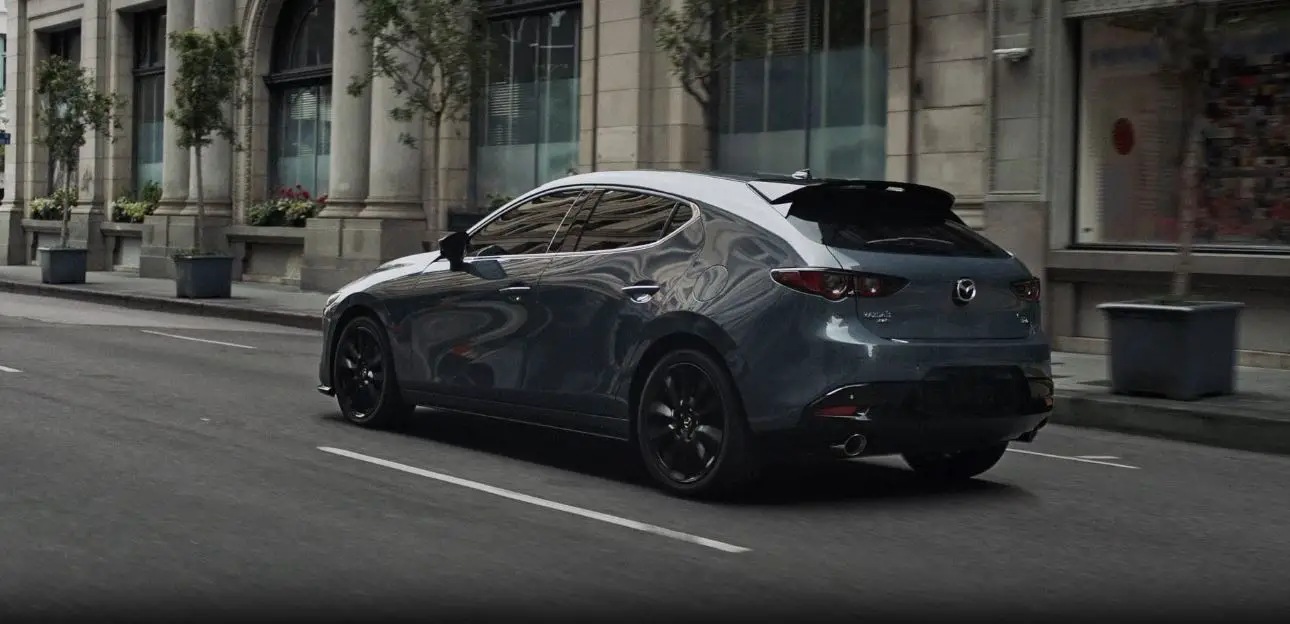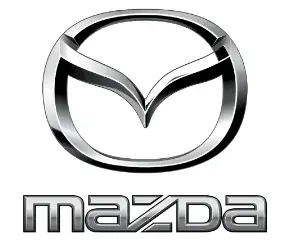 Mazda 3 Hatchback 2023 Fuel and Engine Exhaust User Manual
Mazda 3 Hatchback 2023 Fuel and Engine Exhaust User Manual
Introduction
The Mazda 3 Hatchback 2023 combines performance, efficiency, and cutting-edge technology in an outstanding way. The fuel and engine exhaust system, which is at the heart of this dynamic vehicle, is built to provide the best power and have the least negative influence on the environment. A cutting-edge engine that combines efficiency and performance is included with the Mazda 3 Hatchback 2023. Even though the available engines may differ, Mazda is renowned for its SkyActiv-G technology, which aims to increase fuel efficiency without reducing power output. With this cutting-edge strategy, drivers may take advantage of lively acceleration and responsive handling while consuming the least amount of fuel possible.
The Mazda 3 Hatchback 2023 features cutting-edge technology for engine exhaust that lower emissions and improve environmental friendliness. With the help of Mazda’s SkyActiv-Exhaust technology, the flow of exhaust gases is optimized, increasing engine performance and lowering harmful emissions. This focus on detail supports Mazda’s dedication to sustainability by making driving safer, cleaner, and more environmentally friendly. Additionally, the Mazda 3 Hatchback 2023 offers a range of fuel choices to accommodate varied driver preferences and geographical needs. Mazda aims to offer a variety of options that balance performance and eco-consciousness, whether it be gasoline, diesel, hybrid, or electric powertrains, empowering drivers to make responsible selections based on their own needs.
In conclusion, the Mazda 3 Hatchback 2023’s fuel and engine exhaust system exemplifies Mazda’s commitment to designing cars that give thrilling performance while putting a priority on fuel efficiency and reducing environmental impact. This car exemplifies Mazda’s goal of driving pleasure combined with sustainability thanks to its cutting-edge technologies and variety of fuel options.
Fuel and Engine Exhaust Precautions
Fuel Requirements
Vehicles with catalytic converters or oxygen sensors must use ONLY UNLEADED FUEL, which will reduce exhaust emissions and keep spark plug fouling to a minimum.
To achieve maximum engine performance, use the specified fuel.
|
Fuel |
Octane Rating*1 (Anti-knock index) |
|
Regular unleaded fuel |
87 [(R+M)/2 method] or above (91 RON or above) |
U.S. federal law requires that octane ratings be posted on gas station pumps.
Fuel with a rating lower than 87 octane (91 RON) will negatively affect the emission control system performance and could also cause engine knocking and serious engine damage.
CAUTION
- USE ONLY UNLEADED FUEL.
Leaded fuel is harmful to the catalytic converter and oxygen sensors and will lead to deterioration of the emission control system and or failures. - This vehicle can only use oxygenated fuels containing no more than 10 % ethanol by volume. Damage to the vehicle may occur when ethanol exceeds this recommendation, or if the gasoline contains any methanol. Stop using gasohol of any kind if your vehicle engine is performing poorly.
- Never add fuel system additives other than a Mazda genuine product, otherwise the emission control system could be damaged. Consult an Authorized Mazda Dealer for details.
- Gasohol containing more than 10 % ethanol.
- Gasoline or gasohol containing methanol.
- Leaded fuel or leaded gasohol.
Emission Control System
This vehicle is equipped with an emission control system (the catalytic converter is part of this system) that enables the vehicle to comply with existing exhaust emissions requirements.
WARNING
Never park over or near anything flammable:
Parking over or near anything flammable, such as dry grass, is dangerous. Even with the engine turned off, the exhaust system remains very hot after normal use and could ignite anything flammable. A resulting fire could cause serious injury or death.
CAUTION
Ignoring the following precautions could cause lead to accumulate on the catalyst inside the converter or cause the converter to get very hot. Either condition will damage the converter and cause poor performance.
- USE ONLY UNLEADED FUEL.
- Do not drive your Mazda with any sign of engine malfunction.
- Do not coast with the ignition switched off.
- Do not descend steep grades in gear with the ignition switched off.
- Do not operate the engine at high idle for more than 2 minutes.
- Do not tamper with the emission control system. All inspections and adjustments must be made by a qualified technician.
- Do not push-start or pull-start this vehicle.
NOTE
- Under U.S. federal law, any modification to the original-equipment emission control system before the first sale and registration of a vehicle is subject to penalties. In some states, such modification made on a used vehicle is also subject to penalties.
- While the engine is off, the sound of a valve opening and closing can be heard at the rear of the vehicle, however, this does not indicate an abnormality. The vehicle has a self-checking device and it operates while the engine is off.
Engine Exhaust (Carbon monoxide)
WARNING
Do not drive your vehicle if you smell exhaust gas inside the vehicle: Engine exhaust gas is dangerous. This gas contains carbon monoxide (CO), which is colorless, odorless, and poisonous. When inhaled, it can cause loss of consciousness and death. If you smell exhaust gas inside the vehicle, keep all windows fully open and contact an Authorized Mazda Dealer immediately.
Do not run the engine when inside an enclosed area:
Running the engine inside an enclosed area, such as a garage, is dangerous. Exhaust gas, which contains poisonous carbon monoxide, could easily enter the cabin. Loss of consciousness or even death could occur.
Open the windows or adjust the heating or cooling system to draw fresh air when idling the engine:
Exhaust gas is dangerous. When the vehicle is stopped with the windows closed and the engine running for a long time even in an open area, exhaust gas, which contains poisonous carbon monoxide, could enter the cabin. Loss of consciousness or even death could occur.
Clear snow from underneath and around your vehicle, particularly the tail pipe, before starting the engine:
Running the engine when a vehicle is stopped in deep snow is dangerous. The exhaust pipe could be blocked by the snow, allowing exhaust gas to enter the cabin. Because exhaust gas contains poisonous carbon monoxide, it could cause loss of consciousness or even death to occupants in the cabin.
Fuel-Filler Lid and Cap
WARNING
When removing the fuel-filler cap, loosen the cap slightly and wait for any hissing to stop, then remove it: Fuel spray is dangerous. Fuel can burn skin and eyes and cause illness if ingested. Fuel spray is released when there is pressure in the fuel tank and the fuel-filler cap is removed too quickly.
Before refueling, stop the engine, and always keep sparks and flames away from the filler neck:
Fuel vapor is dangerous. It could be ignited by sparks or flames causing serious burns and injuries. Additionally, use of the incorrect fuel-filler cap or not using a fuel-filler cap may result in a fuel leak, which could result in serious burns or death in an accident.
Do not continue refueling after the fuel pump nozzle shuts off automatically:
Continuing to add fuel after the fuel pump nozzle has shut off automatically is dangerous because overfilling the fuel tank may cause fuel overflow or leakage. Fuel overflow and leakage could damage the vehicle and if the fuel ignites it could cause a fire and explosion resulting in serious injury or death.
CAUTION
- Always use only a genuine Mazda fuel-filler cap or an approved equivalent, available at an Authorized Mazda Dealer. The wrong cap can result in a serious malfunction of the fuel and emission control systems.
(U.S.A. and Canada)
It may also cause the check engine light in the instrument cluster to illuminate. - When using an automatic car wash or a high-water pressure car washer, lock the vehicle. Otherwise, the fuel-filler lid may open unexpectedly and could be damaged.
Refueling
Before refueling, close all the doors, windows, and liftgate/trunk lid, and switch the ignition OFF.
- 1. Using the following, unlock the driver’s door.
- Transmitter
- Touch sensor
- Door-lock switch
- Auto lock/unlock function
NOTE - When unlocking the driver’s door, the fuel lid is also unlocked at the same time.
- When locking the driver’s door, the fuel lid is locked after 90 seconds.
- The time until the fuel lid is locked after locking the driver’s door can be changed. Refer to the Settings section in the Mazda Connect Owner’s Manual.
- However, when the driver’s door is locked using the following functions, the fuel lid is also locked at the same time.
- Press the location shown in the illustration and open the fuel lid.

- To remove the fuel-filler cap, turn it counterclockwise.
- Attach the removed cap to the inner side of the fuel-filler lid.
4–door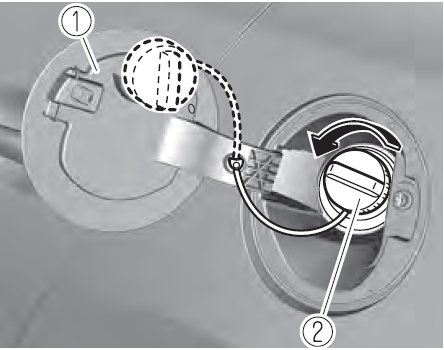 5–door
5–door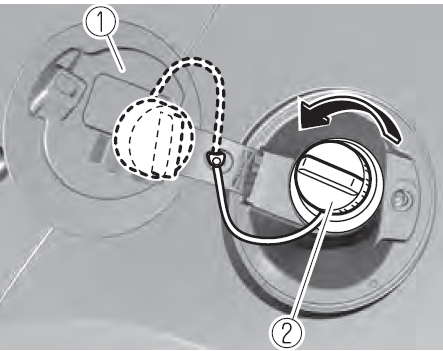
- Insert the refueling nozzle all the way and begin refueling. Pull out the refueling nozzle after the refueling stops automatically.
- To close the fuel-filler cap, turn it clockwise until a click is heard.
- To close, press the fuel-filler lid until a click sound is heard.
4–door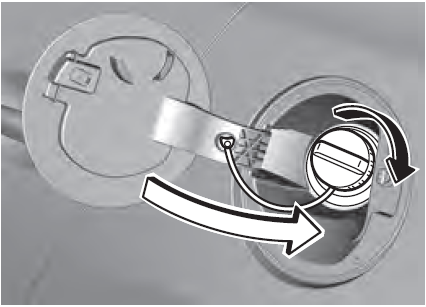 5–door
5–door
- Make sure to lock all the doors when leaving the vehicle.
NOTE
Lock the doors after closing the fuel-filler lid.
If the fuel-filler lid is closed after locking the doors, the fuel-filler lid cannot be locked.
CAUTION
(U.S.A. and Canada)
If the check fuel cap warning light illuminates, the fuel-filler cap may not be properly installed. If the warning light illuminates, park your vehicle safely off the right-of-way, remove the fuel-filler cap and reinstall it correctly. After the cap has been correctly installed, the fuel cap warning light may continue to illuminate until a number of driving cycles have been completed. A drive cycle consists of starting the engine (after four or more hours with the engine off) and driving the vehicle on city and highway roads. Continuing to drive with the check fuel cap warning light illuminated could cause the check engine light to illuminate as well.
FAQs
Regular unleaded gasoline is intended to be used in the Mazda 3 Hatchback 2023.
The Mazda 3 Hatchback 2023 has a fuel tank capacity of roughly 13.2 gallons.
Skyactiv-G engines, which provide great fuel efficiency, are indeed included with the Mazda 3 Hatchback 2023.
The Mazda 3 Hatchback’s fuel efficiency in 2023 will vary based on the engine and road conditions, but it will normally be between 28 and 30 mpg in the city and 36 to 38 mpg on the highway.
Yes, a Skyactiv-X engine with Mazda’s ground-breaking Spark-Controlled Compression Ignition (SPCCI) technology is offered with the Mazda 3 Hatchback 2023. It does not, however, provide a hybrid or all-electric engine option.
Synthetic 0W-20 oil is normally advised for use in the Mazda 3 Hatchback 2023, but it’s always advisable to check the owner’s manual for the exact specifications.
In the majority of markets, the Mazda 3 Hatchback 2023 does not have a diesel engine option.
The Mazda 3 Hatchback 2023 is advised to have its oil changed once every 7,500 miles or once every 12 months, whichever comes first. However, it’s crucial to adhere to the instructions provided by the manufacturer in the owner’s handbook.
To cut down on hazardous emissions, the Mazda 3 Hatchback 2023 has a catalytic converter built into its exhaust system.
The Mazda 3 Hatchback 2023 complies with the emission requirements established by the regulatory bodies in the nations where it is sold.
A gasoline particulate filter (GPF) is included with the Mazda 3 Hatchback 2023 in regions where it is necessary for emissions compliance.
A standard exhaust system with a muffler and tailpipe is included on the Mazda 3 Hatchback 2023 in order to reduce noise and improve engine performance.
It is not advised to change the Mazda 3 Hatchback 2023’s exhaust system because doing so may have a negative impact on performance and emissions and void the warranty.
The engine start-stop capability may be available in some trim levels or optional packages for the Mazda 3 Hatchback 2023. In order to save gasoline, this feature turns the engine off automatically when the car is stopped.
A trained technician should inspect the Mazda 3 Hatchback 2023 if the check engine light comes on in order to identify and address any potential problems with the engine or emissions system.
Useful Links
View Full User Guide: Mazda 3 Hatchback 2023 User Manual| Auto User Guide
Download Link: Owner’s – Manuals, Guides, Maintenance Schedules | Mazda USA

